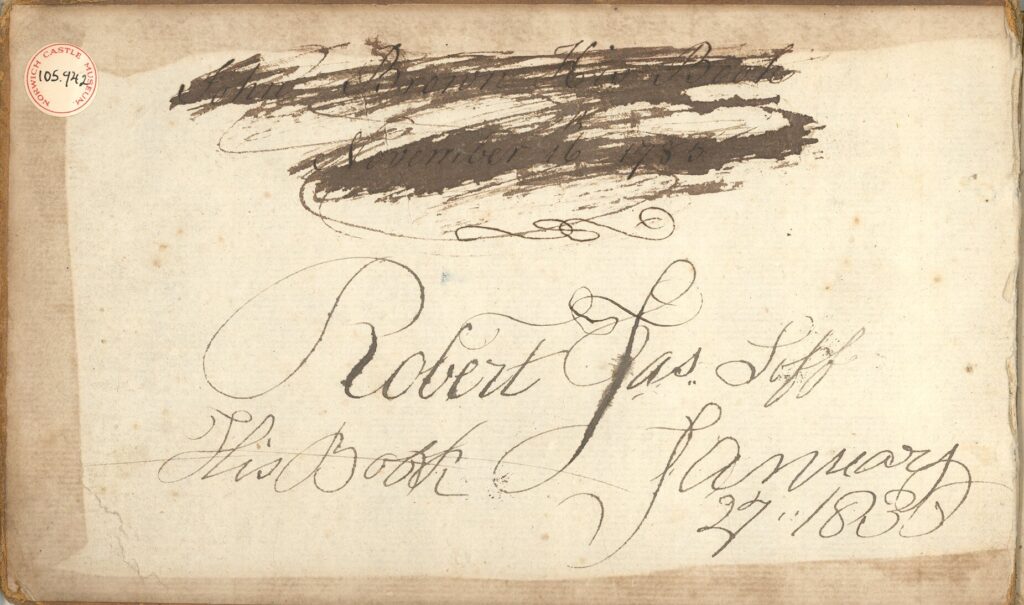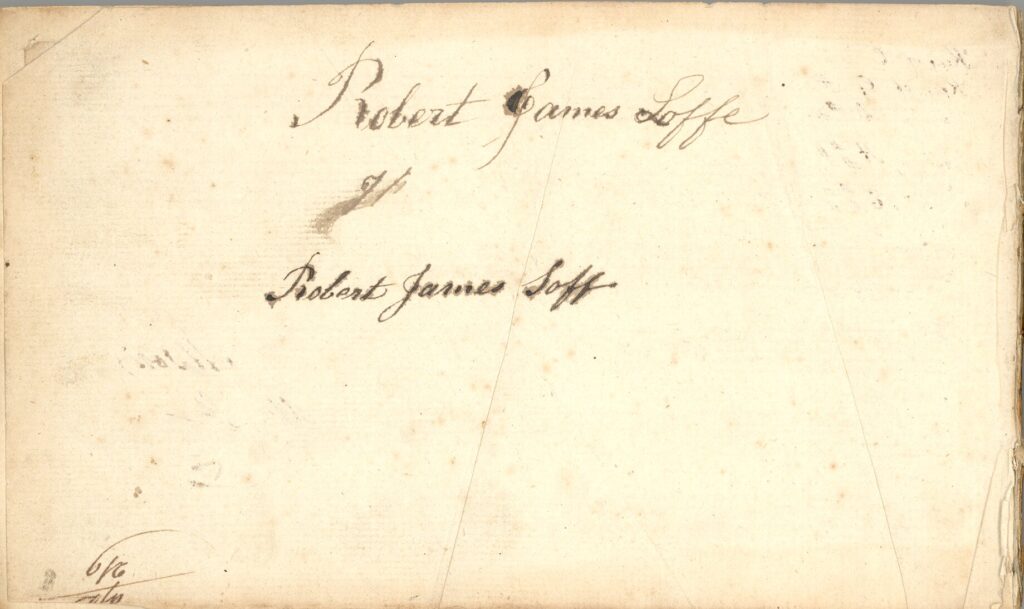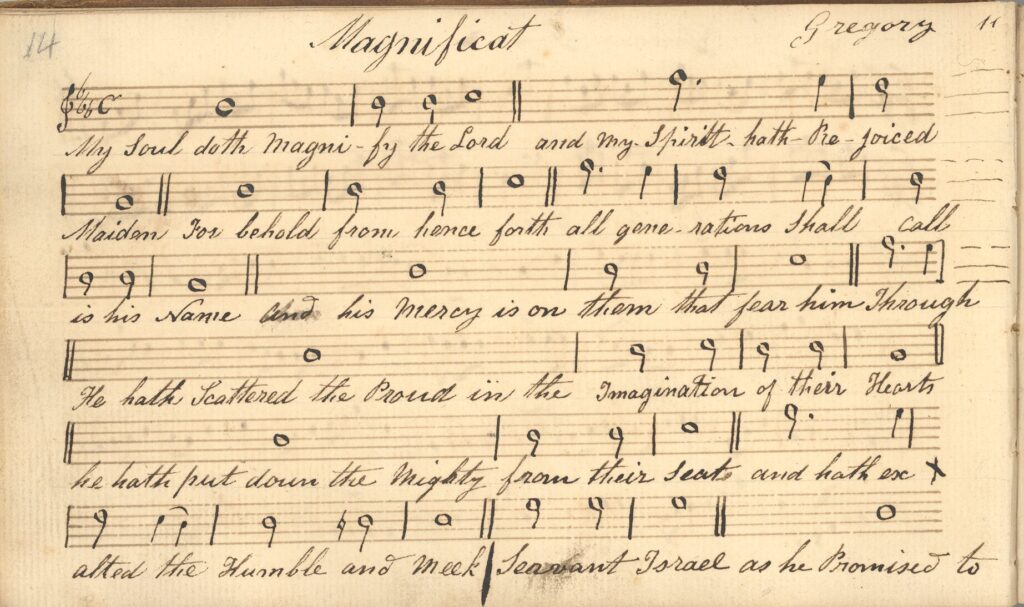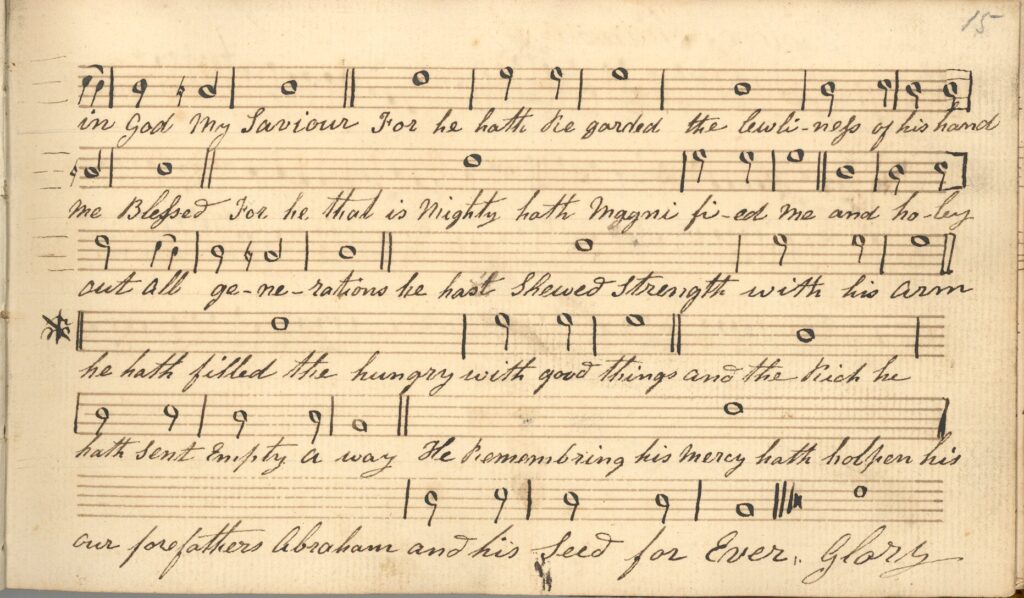Investigations into ownership and format are ongoing – made all the more difficult for a year of Lockdowns and closure of museums. But hopefully, once restrictions are lifted from June 2021, questions may be answered.
All photographs on this page are credited to NWHCM:1942.105.2 Norfolk Museums Service – Strangers’ Hall Museum.
Left image: Under the scribble John Brown His Book 16 November 1785, less clear is the visible name Robert Jas Goff/Goffe/Suff/Soffe. Right image: A neater handwritten name – this appears at the end of the book
Below are thoughts from Alan Helsdon and Flos Headford:
Alan Helsdon
Alan had made the assumption that the second owner of the book was Robert Jas Goff/e when it came to researching the name. He wrote that Goffe’s leaning toward the religious music may be gleaned from the fact that in 1861, after the family had moved from Cawston to Norwich, his son George was a chorister at the Cathedral under Organist and Choirmaster Dr Zechariah Buck, and that George went on to become Assistant Organist at the Cathedral and later gained his Fellowship of the Royal College of Organists and ended his days as Organist at St Albans.
Chris’s thinking is ‘that the book is more likely to come from a village than from the city, where more sophisticated styles of worship would be the norm.’ It was not uncommon for village musicians to hand around manuscripts of music played in their villages and this was a useful line of enquiry and investigation to follow. When originally researching the one time owner Robert Goff, Alan’s findings led me to the village of Cawston, 11 miles north by east of Norwich. Researching the name John Brown was always going to be a tall order but his findings have located two potential John Brown owners born in Cawston in 1769 and 1770 which Alan had thought might allow him to start piecing the jigsaw together.
The thought had been that Robert Jas may have added the hymns following on from John Brown’s dance tunes at the start of the book.
Flos Headford
The inside of the front cover faces a fly-leaf (no staves printed on it) which carries a list of tune titles from the first 4 pages, presumably in the hand of the original owner (J Brown). Flos would like the museum curators to confirm that the other side of the fly-leaf carries no significant information. His assumption is that if there had been writing on the other side, an image of this would have been available.
In addition to this list for the first 4 pages, the leaf marked 1 is a right-hand leaf. Flos writes ‘To my experienced (but I confess, inexpert) eye, the same hand is used for tune titles and annotations as far as page 5. Thereafter is a marked change’.
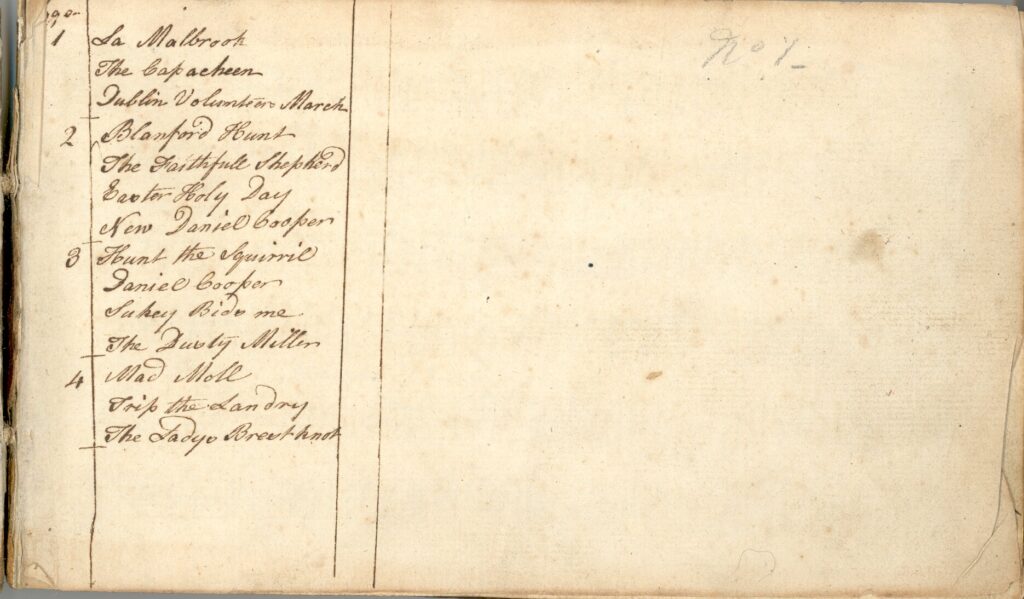
List of first 4 pages 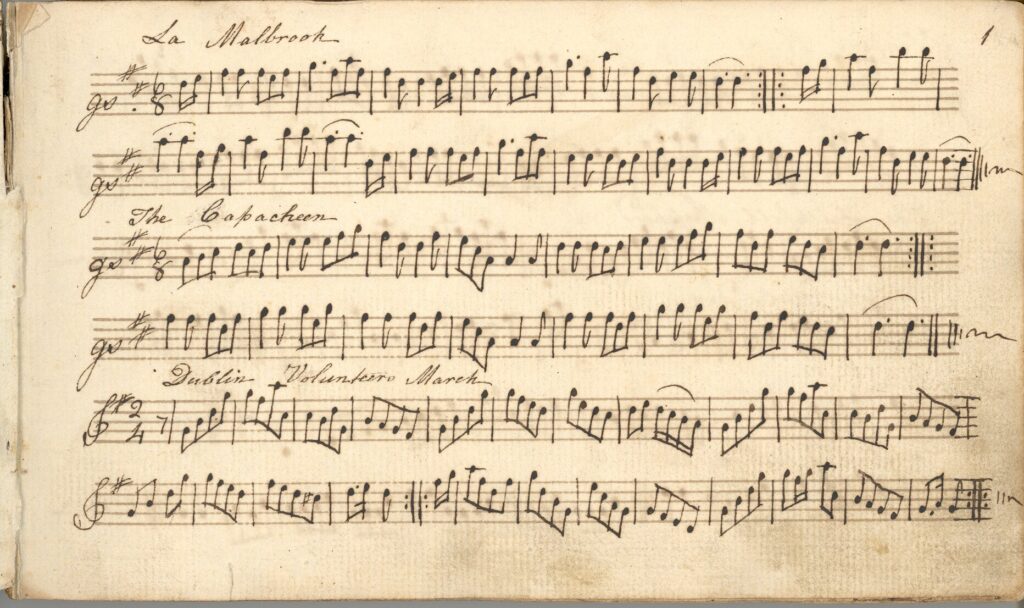
Page 1 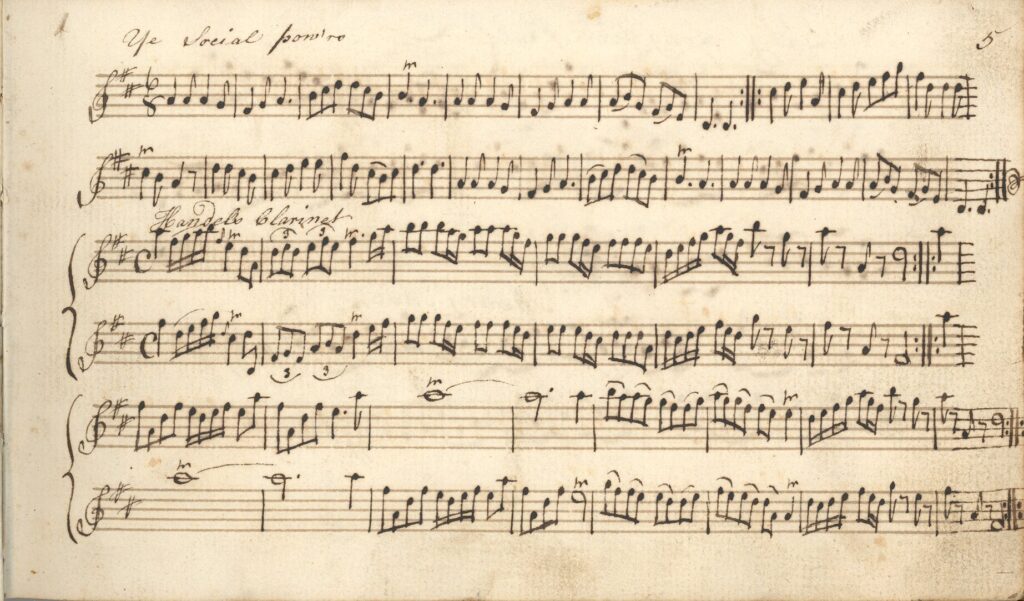
Page 5 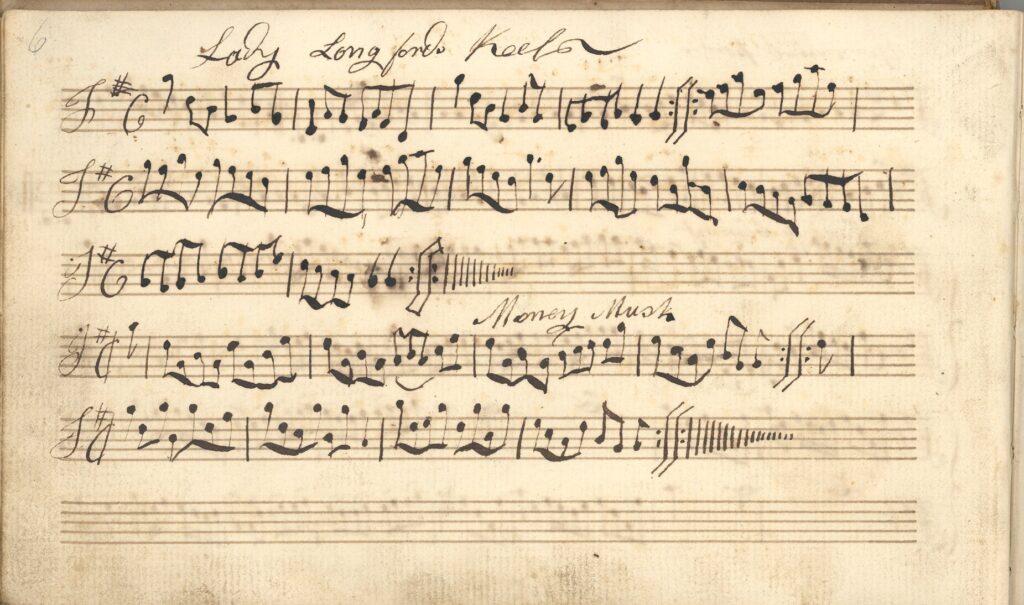
Page 6
Let us label the hand used in the first five numbered pages “JB” (John Brown).
From page 6 to page 13 dance tunes appear to be written in the same hand. Page 14 is the start of the inclusion of sacred music in the manuscript. ‘Personally, I doubt that JB also wrote page 14 (Magnificat), though there is a return to a more disciplined writing style reminiscent of JB’.
Page 14 and 15 – Magnificat
Historical Music Manuscripts
Flos writes ‘The Thomas Hardy music manuscripts, and most of the others which I have handled, used the ‘front’ part of the book for dance tunes. Take a book printed with staves.
‘(This kind of book has been available since about 1650. The earliest printed music book the British Museum has is Italian, from 1530, but has only the bass part.)
‘Take a book printed with staves. Turn it upside down by lifting the bottom edge. If you now open the book, you have a means of writing from either end of the book.
‘That is why most “stave” books have equal margins top and bottom. The common usage was to write church music from one end, and secular music from the other. If a book was full, and you started leafing through the dance tunes, you would meet upside-down hymn tunes from the other end. In such a book, you could make a fairly confident guess about which was the first dance tune written, and which was the first church tune. As for the last of either, you must remember that, especially with sacred music, space may have been allotted in advance. If you were a member of a church band (this is before the ghastly advent of organs and barrel-organs), you might have to wait while a fellow band-member had his turn at the book the church owned, to copy it out.
‘The Brown-Soffe manuscript does not follow this usual ‘turn the book over’ pattern. That is a great pity. But we have fortune on our side when we look at the last of his entries, “Handel’s Clarinet” on page 5. We can make one decisive conclusion. Other hands in the book seem incapable of writing the letter H with parallel upright strokes. John Brown manages a parallel H in “His Book”, vandalised on the inside of the front cover by the clumsy Soffe’.
Church music – single voice to polyphony
Most church music had been single-voice, with no hint of what we would call rhythm, and using scales inaccessible to modern ears. Life wasn’t to be enjoyed! When polyphony (more than one note at a time) became widespread outside the church, the clergy, after many centuries, gave in but sanctioned its use only on sacred ground. Many pieces of outstanding beauty were created. Use of holy music outside the church was made the excuse for punishments (mostly using ropes, blades or fire).
So even in John Brown’s day, Flos doubts that he had free access to holy music in print. By then, four-part harmony had become almost second nature to the English. Writing it down was nowhere near so easy. Flos writes ‘I remember, in the days when I first encountered real folk music, coming home from pub sessions and trying to write down the magical tunes that stuck in my head. I made all the mistakes that the young Thomas Hardy and John Clare had made’.
Handwriting style – English Roundhand
Printed copybooks popularising the English Roundhand style became available from about 1640. These contained sample alphabets, sample missives and instructions on the cutting and maintenance of quills, and some with recipes for the making of inks.
English roundhand was a development from the French rhonde style which in turn descended from the artisans fleeing the dissolution of the Vatican’s Apostolic Camera (clerking house) during the sack of Rome in 1527.
These copybooks were printed using the intaglio printing method, where the ink is transferred from groves in a metal (often copper) plate to the paper. The opposite method, putting ink on a raised surface, was in decline as woodblock printing fell out of use during the 1550s. Copybooks were the source texts for most British schools, who aimed to turn out clerks with a uniform handwriting style.
Quills and Nibs
Almost universally, the goose-feather quill was the pen in use, so a pen knife with very sharp edge was needed, and a skill in using it. Metal nibs had been made, usually as one-off luxury items by craftsmen, and mass manufacture of steel nibs did not start until the 1820s in Birmingham.
A close physical examination of the paper surface might determine which kind of nib was in use, since quill and steel scratch the paper surface in detectably different ways.
Quill and steel nibs require slightly different handling to approximate a copybook style. With either type, a thicker line can be created by the application of more pressure. Much practice with a delicate hand can produce elegant results.
The stark clumsiness of page 6 comes as a shock. As does the pretensions to elegance in the use of wobbly, thick lines for bridging quavers. One hopes that the excuse of youthful inexperience with a pen is to blame.
Things start to calm down from page 12 on, though there is a lack of consistency in the stems of the lowercase d. Some stems are plain, others loop over and cross the upright. See page 14 and look for “alted the Humble and”, below the bottom staff. This is the first sacred tune in the MS, and one expects a modicum of reverence to have attended its inscription.

Page 6 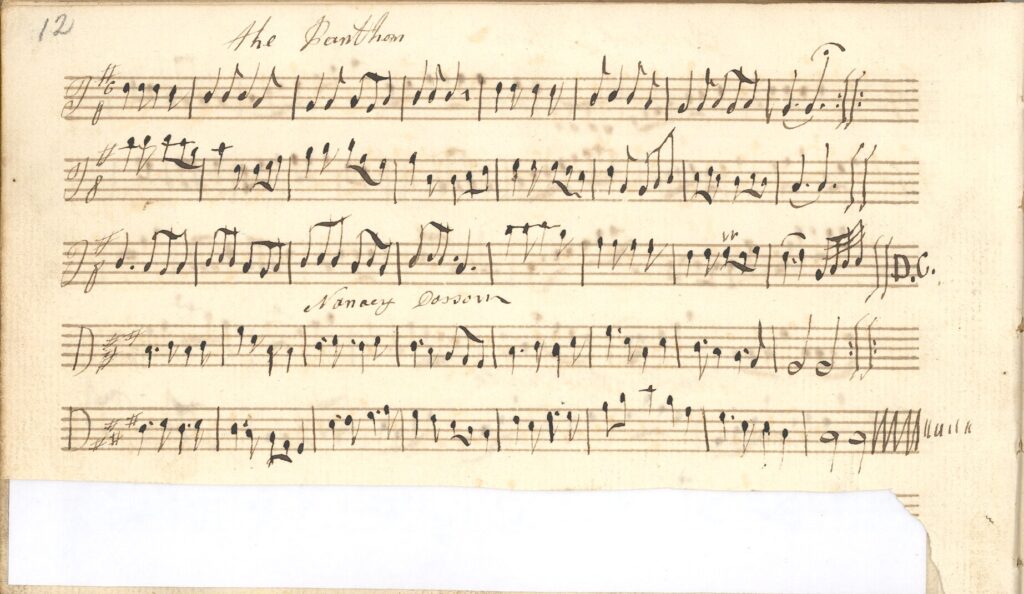
Page 12 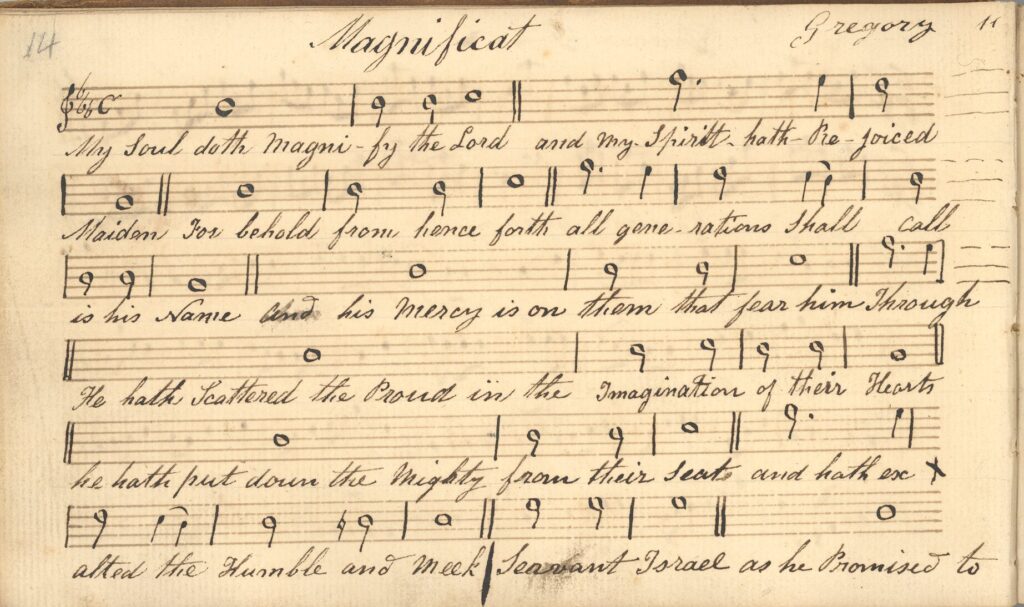
Page 14
From page 16, the hand seems more mature, and with a better nib. “Handel’s Clarinet” on page 5 is the first tune in the book that I would say is definitely copied from a book. From page 16 onwards, I would say that (with the exception of a few fragments) everything is copied from printed source(s).
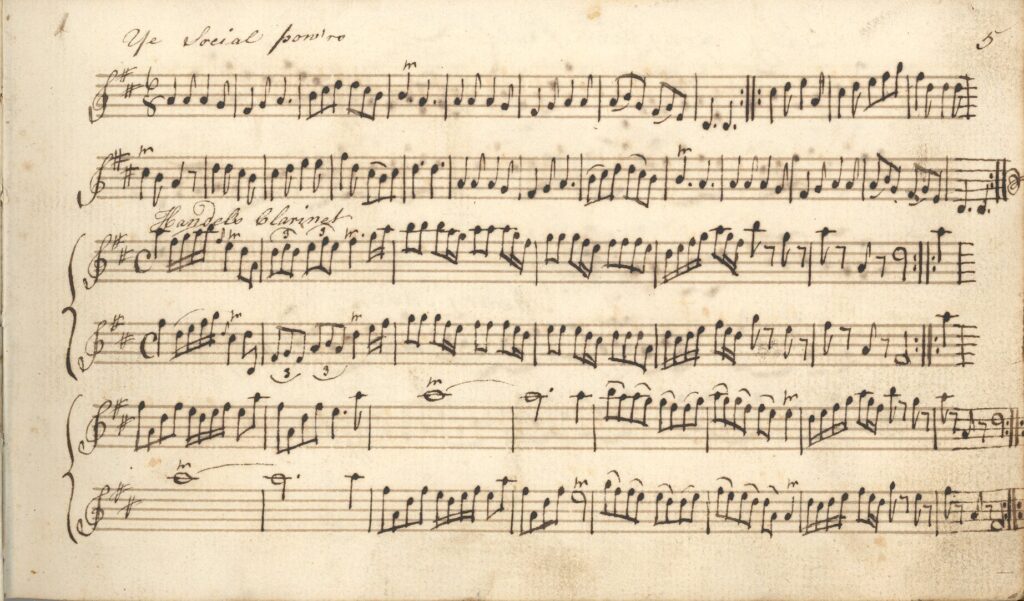
Page 5 Handel’s Clarinet 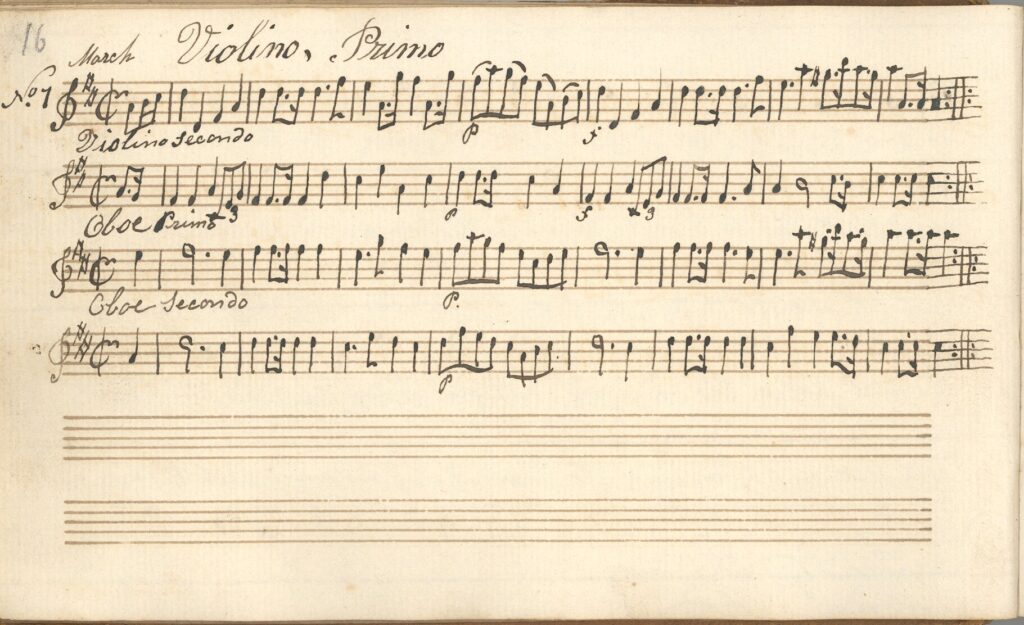
Page 16
We can say with some certainty that “Handel’s Clarinet” is not by Handel, since his works have been exhaustively catalogued. It might be by Jeremiah or another of the Clarks or Clarkes, or by Purcell.
A musician – back in the days
Flos continues ‘Imagine yourself as a musician in an age when there was no such thing as recorded music. A time when all lighting meant flames. And all musical instruments are vastly expensive. A local rich person wants to show off by staging a dance (a “ball”) or a local farmer wants to have dance for an anniversary, or his daughter’s wedding (a “barn dance”). Since almost everybody goes to church, the obvious contact is the church band. So, for the farmer, the church band meets to practice the “pop” tunes of the day (what we now call “folk dance tunes”). But if you want to get into the big money offered by the “big houses”, you have to prove that you can play the kind of music that musicians hired from London or Norwich play. “Dancing Masters” will have been touring the country teaching the sons and daughters of the big houses the latest fashions. Remember, too, that the big dances would have been observed by maids and menservants with good memories, who spread those fashions further afield.
‘In addition to the demands of the church (fifty-two Sundays multiplied by several hymns), the church band will snaffle copies of any “posh house” tunes they can.
‘And while it’s possible to memorise several parts for hundreds of tunes, it’s more secure to write down little-used items or tunes that fall in the category “I really must learn that”. These, I think, are reasons why items like “Handel’s Clarinet” and “Opera dance” often turn up in fiddlers’ tune books. Flute-players’ tune books show a great similarity to fiddlers’ books’.
